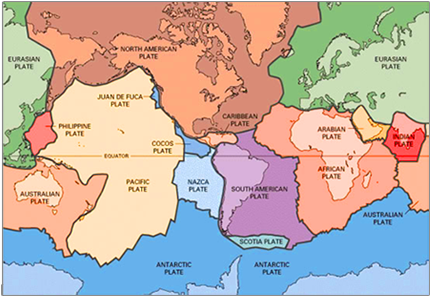|
Can Tsunamis Occur in the Caribbean?
 The Caribbean Islands lie in a tectonic setting where the North American plate is sinking beneath the Caribbean plate giving rise to earthquakes and volcanic activity. In this setting earthquakes (underwater or those occurring close to the shore) that rupture the crust may generate tsunamis. Volcanic eruptions and landslides (coastal or beneath the ocean) may also generate tsunamis. As a consequence, the entire arc may be considered a potential source for tsunami generation. The Caribbean Islands lie in a tectonic setting where the North American plate is sinking beneath the Caribbean plate giving rise to earthquakes and volcanic activity. In this setting earthquakes (underwater or those occurring close to the shore) that rupture the crust may generate tsunamis. Volcanic eruptions and landslides (coastal or beneath the ocean) may also generate tsunamis. As a consequence, the entire arc may be considered a potential source for tsunami generation.
Tsunamis have been observed in the Caribbean and its adjacent seas since the 16th century. Both local and distant (tele-tsunamis) tsunamis have affected this region at the rate of one or more severe occurrences per century. Indeed in the year 1755 the Great Lisbon earthquake near Portugal caused a tele-tsunami “as high as the upper storey’s of houses” on the east coast of Martinique. Waves 2m high were also observed at the east coast of Barbados. Tsunamis have impacted the region in the past and are therefore, expected to occur in the future.
Tsunami Sources in the Caribbean
All common sources capable of generating tsunamis are evident within the Caribbean (earthquakes, volcanic eruptions and landslides). There is also the potential for tele-tsunamis from sources across the Atlantic.
Tsunamis Triggered by Earthquakes
In the past 500 years there have been at least ten confirmed earthquake generated tsunamis in the Caribbean Basin with four causing fatalities. An estimated number of more than 3000 persons were killed by these events. (Caribbean History)
Since the Caribbean islands lie in an area of moderate earthquake activity, the most likely tsunamis to affect the Caribbean would be those triggered by shallow (<50km depth) earthquakes of magnitude greater than 6.5 within the region.
Potentially, there are two groups of earthquakes which may generate tsunamis in the Caribbean.
1. Earthquakes occurring within the region which may generate local tsunamis (by local we mean only nearby coastlines within 100km are affected). In the past 500 years, there have been approximately 50 local earthquakes with the potential to cause a tsunami but only 10-20% of these earthquakes actually generated tsunamis that caused significant flooding.
2. Distant earthquakes occurring outside of the region may generate tele-tsunamis. These pose a somewhat lower threat than tsunamis caused from local earthquakes. The primary tele-tsunami sources are the Azores-Gibraltar fracture zone that produced the well documented Lisbon Earthquake and Tsunami near Portugal in 1755 and the La Palma Volcano in the Canary Islands.
Tsunamis Triggered by Volcanic Eruptions
Although relatively infrequent, tsunamis can also be caused by large volcanic eruptions at or below sea level. In the Eastern Caribbean the submarine volcano, Kick‘em Jenny located 9 km north-west of Grenada erupts on average every 11 years. Two of those eruptions, in 1939 and 1965, are known to have generated small tsunamis that were witnessed on the north coast of Grenada. However, based on detailed studies of the physical structure of Kick‘em Jenny scientists currently consider that there is a very small chance that an eruption of the volcano would trigger a tsunami. Any tsunamis triggered by underwater eruptions are a potential hazard for neighbouring islands in particular.
Vulnerability of Caribbean Islands to Tsunamis
The vulnerability of particular islands to the tsunami hazard is not the same throughout the Caribbean. The north-eastern Caribbean region near Puerto Rico and Hispaniola is more susceptible to tsunamis due to the level of seismic activity present, and the average rate of occurrence in this area has approached 1 every 50 years in the last 200 years . In other sub-regions such as the southern Caribbean, there are no historical records of destructive tsunami impacts.
All coastal areas throughout the region are vulnerable to the impact of tsunamis. Low lying areas are generally more impacted and could be severely flooded by the waves, as was evident in the 2004 Indian Ocean Tsunami where the waves impacted areas as far as 3km inland. The height of a tsunami wave depends on a number of factors, including the characteristics of the event that triggered the tsunami, the depth of the water (bathymetry) and the topography of the ocean floor. The nature of the impact of the tsunami on particular coastlines will depend largely on proximity to the source of the tsunami, topography and settlement characteristics.
|